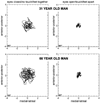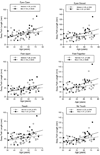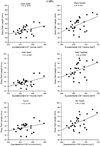Postural sway reduction in aging men and women: relation to brain structure, cognitive status, and stabilizing factors
- PMID: 17920729
- PMCID: PMC2684797
- DOI: 10.1016/j.neurobiolaging.2007.08.021
Postural sway reduction in aging men and women: relation to brain structure, cognitive status, and stabilizing factors
Abstract
Postural stability becomes compromised with advancing age, but the neural mechanisms contributing to instability have not been fully explicated. Accordingly, this quantitative physiological and MRI study of sex differences across the adult age range examined the association between components of postural control and the integrity of brain structure and function under different conditions of sensory input and stance stabilization manipulation. The groups comprised 28 healthy men (age 30-73 years) and 38 healthy women (age 34-74 years), who completed balance platform testing, cognitive assessment, and structural MRI. The results supported the hypothesis that excessive postural sway would be greater in older than younger healthy individuals when standing without sensory or stance aids, and that introduction of such aids would reduce sway in both principal directions (anterior-posterior and medial-lateral) and in both the open-loop and closed-loop components of postural control even in older individuals. Sway reduction with stance stabilization, that is, standing with feet apart, was greater in men than women, probably because older men were less stable than women when standing with their feet together. Greater sway was related to evidence for greater brain structural involutional changes, indexed as ventricular and sulcal enlargement and white matter hyperintensity burden. In women, poorer cognitive test performance related to less sway reduction with the use of sensory aids. Thus, aging men and women were shown to have diminished postural control, associated with cognitive and brain structural involution, in unstable stance conditions and with diminished sensory input.
Figures










Similar articles
-
Mechanisms of postural control in alcoholic men and women: biomechanical analysis of musculoskeletal coordination during quiet standing.Alcohol Clin Exp Res. 2010 Mar 1;34(3):528-37. doi: 10.1111/j.1530-0277.2009.01118.x. Epub 2009 Dec 17. Alcohol Clin Exp Res. 2010. PMID: 20028360 Free PMC article.
-
The relationship between hippocampal volume and static postural sway: results from the GAIT study.Age (Dordr). 2016 Feb;38(1):19. doi: 10.1007/s11357-016-9883-4. Epub 2016 Feb 1. Age (Dordr). 2016. PMID: 26833034 Free PMC article.
-
Additional sensory information reduces body sway of individuals with anterior cruciate ligament injury.Neurosci Lett. 2008 Aug 29;441(3):257-60. doi: 10.1016/j.neulet.2008.06.039. Epub 2008 Jun 19. Neurosci Lett. 2008. PMID: 18582536
-
Age-related changes in human and non-human primate white matter: from myelination disturbances to cognitive decline.Age (Dordr). 2012 Oct;34(5):1093-110. doi: 10.1007/s11357-011-9357-7. Epub 2011 Dec 28. Age (Dordr). 2012. PMID: 22203458 Free PMC article. Review.
-
Aging, training, and the brain: a review and future directions.Neuropsychol Rev. 2009 Dec;19(4):504-22. doi: 10.1007/s11065-009-9119-9. Epub 2009 Oct 30. Neuropsychol Rev. 2009. PMID: 19876740 Free PMC article. Review.
Cited by
-
Deactivation of somatosensory and visual cortices during vestibular stimulation is associated with older age and poorer balance.PLoS One. 2019 Sep 12;14(9):e0221954. doi: 10.1371/journal.pone.0221954. eCollection 2019. PLoS One. 2019. PMID: 31513630 Free PMC article.
-
Balance and Posture in Children and Adolescents: A Cross-Sectional Study.Sensors (Basel). 2022 Jun 30;22(13):4973. doi: 10.3390/s22134973. Sensors (Basel). 2022. PMID: 35808468 Free PMC article.
-
Linking objective measures of physical activity and capability with brain structure in healthy community dwelling older adults.Neuroimage Clin. 2021;31:102767. doi: 10.1016/j.nicl.2021.102767. Epub 2021 Jul 24. Neuroimage Clin. 2021. PMID: 34330086 Free PMC article.
-
Effects of neurofeedback on standing postural control task with combined imagined and executed movements.Front Neurosci. 2023 Jul 7;17:1199398. doi: 10.3389/fnins.2023.1199398. eCollection 2023. Front Neurosci. 2023. PMID: 37483338 Free PMC article.
-
Salivary 1,5-Anhydroglucitol and AGEs Are Associated with Postural Instability in Diabetic Foot Patients.Medicina (Kaunas). 2025 May 23;61(6):968. doi: 10.3390/medicina61060968. Medicina (Kaunas). 2025. PMID: 40572656 Free PMC article.
References
-
- American Psychiatric Association. Diagnostic and Statistical Manual of Mental Disorder (DSM-IV) Washington: American Psychiatric Association; 1994.
-
- Baker K, Harding A, Halliday G, Kril J, Harper C. Neuronal loss in functional zones of the cerebellum of chronic alcoholics with and without Wernicke’s encephalopathy. Neuroscience. 1999;91(2):429–438. - PubMed
-
- Balasubramaniam R, Riley MA, Turvey MT. Specificity of postural sway to the demands of a precision task. Gait Posture. 2000;11(1):12–24. - PubMed
-
- Baloh RW, Ying SH, Jacobson KM. A longitudinal study of gait and balance dysfunction in normal older people. Arch. Neurol. 2003;60(6):835–839. - PubMed
-
- Bortolami SB, Rocca S, Daros S, DiZio P, Lackner JR. Mechanisms of human static spatial orientation. Exp. Brain Res. 2006;173(3):374–388. - PubMed
Publication types
MeSH terms
Grants and funding
LinkOut - more resources
Full Text Sources
Medical

